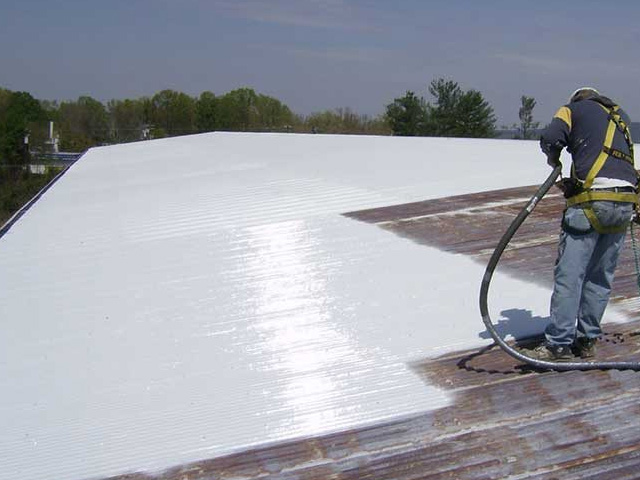When protecting the integrity of a flat roof or metal roof, the selected coating plays a vital role in everything from aesthetics to weather resistance.
Two common options, acrylic and silicone roof coatings, bring unique chemistry.
Acrylic coatings, often chosen for their pleasing appearance and cost-effective nature, must contend with issues such as brittleness and moisture absorption.
In contrast, silicone coatings, formed with elastomers, excel in waterproofing and resisting ponding water but can be more expensive.
Environmental factors such as temperature, using solvents, and the desire to choose environmentally friendly options also weigh into this decision.
In addition, considerations of underlying materials, such as concrete, foam, or bitumen, influence the choice between these coatings.
WeatherStar technology might be implemented for added durability.
This article will solidify your understanding of these complex considerations, exploring how each option impacts not only the solid structure of the roof but also long-term factors such as organic compound content and the overall expenditure of money.

Overview of Acrylic Roof Coating
Acrylic roof coatings are commonly used in the United States for various roofing substrates, such as polyurethane foam, thermoplastic olefin, and polyvinyl chloride.
Created through a specific manufacturing process, these coatings primarily consist of poly(methyl methacrylate) and are known for their ultimate tensile strength.
They’re often employed to improve reflectance, which aids in energy conservation.
One of the main questions in evaluating roofing materials is their ability to stand up to different environmental conditions.
The coating’s ultraviolet resistance is significant, stemming from its inherent properties and sometimes boosted by additives such as chalk.
These coatings are generally applied as a liquid, often using spray foam techniques, which then dries to form a protective membrane.
The adhesion to the substrate is generally good, making it suitable for a wide range of applications, including EPDM rubber and mineral-based surfaces.
Acrylic coatings have downsides, such as sensitivity to freezing temperatures and limitations in ponding water.
Regarding volatile organic compounds, acrylic options generally contain fewer, making them a more environmentally friendly option for those concerned about environmental remediation.
Traditional solvents like white spirit are rarely used, adding to their favorable profile in natural environments.
Pound for pound, acrylic coatings offer a range of benefits and some limitations crucial for soil and other substrate chemistry considerations.
They are different from acrylic paint, which is not specifically designed for the harsh conditions that roofing materials must endure.
Overall, these coatings present a viable choice, especially when factors like energy conservation, the natural environment, and substrate adhesion are paramount.
Advantages:
- Aesthetically pleasing: Acrylic roof coatings are known for excellent color retention.
- Environmentally friendly: They generally contain fewer volatile organic compounds than other coatings.
- Cost-effective: These coatings are usually less expensive upfront than other options like silicone.
- Easy to apply: Being water-based, acrylic coatings can be applied easily through various methods, including spray.
- UV resistant: These coatings offer moderate resistance to ultraviolet rays, which can benefit long-term durability.
Disadvantages:
- Moisture sensitive: These coatings are not ideal for areas prone to water ponding.
- Temperature limitations: Acrylic coatings can become brittle in freezing conditions.
- Lower durability: While generally robust, they usually require more frequent reapplication than other coatings.
- Limited handling of harsh environments: They may be less effective in extremely challenging environmental conditions than other options.
- Less flexibility: Generally less elastic than silicone coatings, which means they may be more prone to cracking.
Overview of Silicone Roof Coating
Silicone roof coatings are renowned for their durability and robustness, particularly regarding waterproofing and resistance to ponding water—common issues in flat roofs.
These coatings are often chosen in the United States for their adaptability to various substrates, including metal, foam, bitumen, and concrete roofs.
![]()
The chemistry of silicone roof coatings revolves around silicone elastomers, which give the coating its high ultimate tensile strength and moisture-resisting capabilities.
Regarding environmental factors, silicone coatings resist temperature variations and ultraviolet radiation, making them a long-lasting solution.
Reflectance is another strong suit; these coatings can effectively reflect heat and UV rays, contributing to energy conservation.
The manufacturing process usually adheres to environmentally friendly standards, and the coatings generally contain fewer volatile organic compounds, aligning well with environmental remediation efforts.
However, when the question of money comes up, it’s important to note that silicone coatings often come with a higher initial cost than other types, such as polyurethane or acrylic coatings.
The application can be more labor-intensive, frequently requiring the spray method for a uniform coating.
While they adhere well to a range of substrates, including thermoplastic olefin and polyvinyl chloride, they might require a solvent or special preparation for optimal adhesion, especially when applied over EPDM rubber or poly(methyl methacrylate).
Aesthetically, silicone roof coatings may lag behind their acrylic counterparts.
They are prone to “chalking,” a phenomenon where the surface becomes powdery over time.
Yet, this brittleness rarely compromises their core function of providing a solid, waterproof layer.
Advantages:
- Waterproofing is excellent, making it suitable for areas prone to ponding water.
- Durability is a strong suit, offering high resistance to environmental factors like UV rays and temperature variations.
- Environmentally friendly due to lower volatile organic compound content.
- Good reflectance properties that assist in energy conservation by deflecting heat.
Disadvantages:
- Higher initial cost compared to other roofing options like acrylic coatings.
- Application can be labor-intensive, requiring specialized techniques or equipment.
- Adhesion to certain substrates might require additional preparation or use of solvents.
- It may suffer aesthetically over time, with the surface becoming powdery or experiencing “chalking.”
Silicone vs Acrylic: Comparison
The first step in deciding between acrylic and silicone roof coatings is understanding the key metrics by which they are generally evaluated.
These include waterproofing abilities, tensile strength, and environmental friendliness.

Acrylic coatings are often water-based solutions made from acrylic polymers.
Silicone coatings, on the other hand, are made of silicone elastomers that provide robust waterproofing.
Waterproofing is a significant concern, especially for flat roofs prone to ponding.
While silicone excels in this department, acrylic coatings may require more frequent reapplication to maintain their water-resistant qualities.
The coating’s ultimate tensile strength measures durability.
Silicone usually comes out on top, offering a more durable solution that can withstand various environmental conditions.
Application Process: What to Expect
The method of applying these coatings often varies. Acrylic coatings are water-based and usually easier to apply.
They are compatible with various application methods, from rollers to spray systems. Silicone coatings require more preparation and are generally applied through spraying to ensure an even layer.
Both coatings require a clean substrate for optimal adhesion. This means the existing roof material, whether metal, foam, or bitumen, should be cleaned and prepped adequately before application.
The temperature and weather conditions can also affect the application. Acrylic coatings are sensitive to temperature and cannot be applied in freezing conditions.
Silicone coatings are less affected by temperature fluctuations, allowing for a wider application window. The drying time for both coatings varies.
Acrylics tend to dry quicker but require a clear weather window for application. Silicone coatings, being more robust against moisture, offer more flexibility.
While both coatings adhere well to various substrates, silicone may require a primer or additional layers for optimal adhesion, increasing labor and material costs.
Cost Analysis: Budgeting for Your Project
When budgeting for a roofing project, several factors come into play. The material costs for silicone are generally higher than for acrylic coatings.

However, the increased durability and lower maintenance of silicone might offset the initial higher expenditure over the long term. Installation costs can also vary.
While acrylics are generally easier and quicker to install, silicones require more specialized equipment and techniques, potentially increasing labor costs.
It’s also essential to consider maintenance costs. Acrylic coatings might require frequent reapplication, especially in environments with significant temperature fluctuations or ponding water.
However, regarding energy savings, both coatings offer good reflectance properties, helping to reduce cooling costs during hot months. This is an important factor that could contribute to long-term savings.
Aesthetic Considerations: Look and Feel
While functionality often precedes roofing materials, aesthetics can’t be entirely discounted.
Acrylic coatings are known for their excellent color retention properties. They can keep your roof looking new and vibrant longer than silicone coatings, which may experience chalking over time.
Silicone coatings are generally available in a more limited range of colors. This can be a disadvantage if aesthetics are a significant consideration for your project.
However, it’s essential to note that while acrylics maintain their color better, they can become brittle and lose their flexibility more quickly than silicone, which could affect the overall appearance over time.
Chalking in silicone coatings can also be seen as a form of natural cleaning, as the powdery substance often washes away dirt and debris, potentially keeping the roof cleaner over the long term.
Environmental Impact: A Closer Look
Both acrylic and silicone coatings have made strides in becoming more environmentally friendly.
Silicone coatings generally contain fewer volatile organic compounds and align well with standards for environmental remediation. They are often the go-to option for projects requiring strict environmental guidelines.
Acrylic coatings, while not as environmentally robust as silicone, are improving.
Newer formulations contain fewer harmful solvents and additives, making them a viable option for those seeking a more budget-friendly yet environmentally responsible choice.
The manufacturing process for both types of coatings has also evolved to become more environmentally friendly. Waste is minimized, and manufacturers are increasingly adopting energy-efficient methods.
It’s also worth mentioning that both types of coatings contribute to energy conservation by reflecting heat, thus reducing the energy required for cooling buildings.
Which Is Better, Silicone or Acrylic?
Determining whether silicone or acrylic roof coating is “better” depends on various factors, such as your specific needs, the climate in which the building is located, and your budget.
Here is a quick breakdown to help guide your decision:
Silicone Coatings:
a. Strengths: Excellent in waterproofing and highly durable. They withstand environmental factors like UV rays and temperature fluctuations very well.
Silicone coatings are usually more environmentally friendly, with fewer volatile organic compounds.
b. Weaknesses: Higher initial costs both for material and potential labor. Limited color options and prone to chalking over time.
They may require more specialized application techniques.
Acrylic Coatings:
a. Strengths: Generally easier and less expensive to install. Excellent color retention and a broader range of colors.
Better adhesion to various substrates without the need for additional primers or layers in many cases.
b. Weaknesses: Not as durable as silicone, especially when ponding water.
They are more sensitive to environmental conditions and may require more frequent reapplication. Acrylics can become brittle over time.
When to Choose Silicone:
- If you’re in an area with extreme weather conditions.
- If the roof experiences ponding water.
- If you want a more environmentally friendly option.
- If you’re looking for longer-lasting durability and willing to invest upfront for lower maintenance later.
When to Choose Acrylic:
- If initial costs are a significant concern.
- If you have aesthetic preferences, such as specific color needs.
- If you are in a moderately stable environment without extreme temperature fluctuations or ponding water issues.
- If you prefer an easier and potentially quicker application process.
Final Thoughts:
Choosing between acrylic and silicone roof coatings ultimately involves understanding your needs, budget constraints, and environmental considerations.
Both materials have their unique strengths and weaknesses, making neither universally superior to the other.
If you’re looking for a solution that excels in durability, is less affected by extreme environmental conditions, and is more environmentally friendly.
Silicone may be the ideal choice for you. On the flip side, if upfront cost, ease of application, and aesthetics are your primary concerns, then acrylic coatings offer a compelling option.
It’s essential to perform a comprehensive evaluation of your roofing situation.
Consult with professionals, get multiple quotes, and consider your choice’s short-term and long-term implications.
By doing so, you’ll be better equipped to make an informed decision that aligns with your specific roofing needs, ultimately ensuring you get the best performance and value out of your investment.

Arthur is a skilled roof worker with over 10 years of experience in the industry. He started his career as an apprentice and worked his way up to become a foreman.
When he’s not working on roofs, John enjoys with his family or writing posts. He is also a passionate cyclist.
